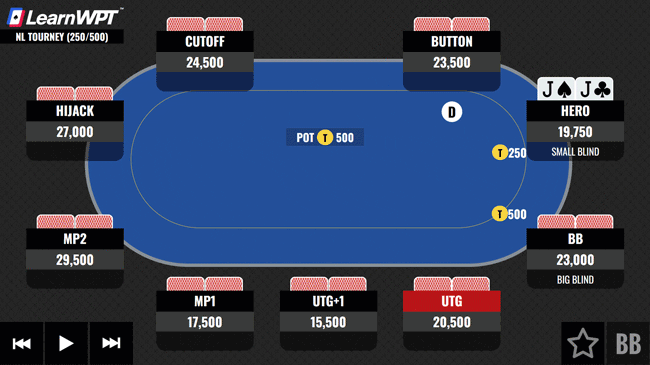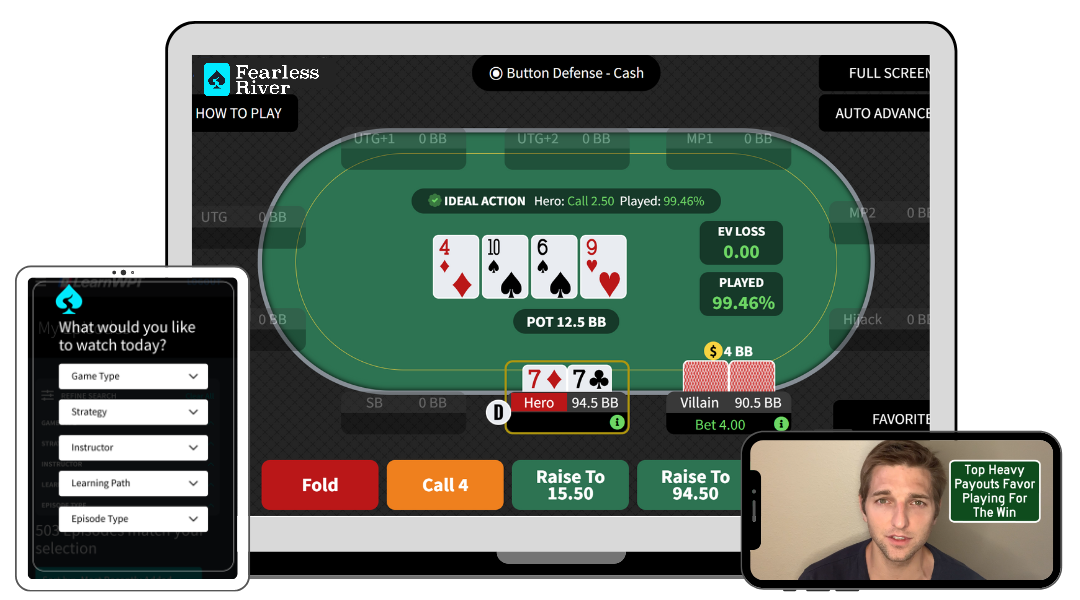[FREE VIDEO] LuckyChewy Vs Daniel Negreanu

Poker legend and LearnWPT Instructor Andrew "LuckyChewy" Lichtenberger used his steady and mindful poker approach to become a $100,000 buy-in WPT Alpha 8 Champion, WSOP Bracelet winner, and secure more than $11 Million in live poker tournament earnings.
He doesn't compare himself or his progress to anyone else's, but rather works on strengthening his own poker skills. Due to his dedication to learning and improvement LuckyChewy has been an innovative catalyst for new poker strategies throughout his entire career. By adopting a meditative attitude he is able to execute optimal strategies under tremendous pressure, providing a key balance for his analytical and collaborative approach to learning and playing poker.

LuckyChewy's opponent in this hand was another legend, Daniel Negreanu, one of the most influential and successful poker players worldwide as well as a favorite of poker fans with his distinctive and fun personality. Having played poker since he was a teenager, testing his skills and moving up in levels while plugging leaks and studying the game, he eventually became the youngest player to win a WSOP Bracelet at 23 years old, eventually winning 6 WSOP Bracelets. Daniel is no stranger to success on the World Poker Tour® as a 2 time WPT champion and WPT Season III Player of the Year, which helped him amass over $45 Million in tournament earnings.
As the subject of a LearnWPT Strategy Episode, LuckyChewy reviewed a hand he played against Daniel Negreanu in the $300,000 buy-in Super High Roller Bowl and explored some strategic ideas as a result of how this hand played out. LuckyChewy describes exactly what he was thinking after flopping a huge hand with millions of dollars at stake.
This video is part of our High Stakes with LuckyChewy Strategy Episode series where Chewy takes a deep dive into his most interesting and useful hands from real WPT and WSOP Final tables and teaches strategies and concepts you can use in your game.
Watch This FREE Strategy Episode From LearnWPT Instructor LuckyChewy!
In this ultra-high stakes tournament, LuckyChewy opened 2.5x the big blind, effectively risking what's in the pot with the blinds and antes. Daniel elected to 3-bet to 27,000, or 9 big blinds total. LuckyChewy had a fairly straightforward call with pocket fours and flopped a bottom set with a backdoor flush draw on the A♣9♣4♥ flop. With the in-position player having the range advantage, LuckyChewy checks and Daniel bets around one-quarter of the pot.
LuckyChewy decided to raise slightly more than 3 times his bet, knowing that Daniel is not likely to reraise him with anything because he already had the range advantage. With this stack depth, it's not recommended to play aggressively against LuckyChewy’s range, as he's quite polarized. There's not any reason for Daniel to raise, because if he has a strong value hand he prefers the opponent to keep bluffing or betting his weaker value hands. Daniel does call and the turn is a texture-changing card, the 2♣.
Based on the solver study, LuckyChewy initially thought this was a card that would encourage Daniel to slow down on, use smaller bet sizes to not bloat the pot. The solver actually recommends a larger bet of around 2/3 of the pot as you should push an equity advantage on a card that's better for you than it is for your opponent. However, if you bet a larger size, you would get way more folds than the solver prefers and your opponent is expected to fold hands as strong as AK.
The deeper you get into the game tree, the more assumptions you have to make about how your opponent would respond in order to determine the appropriate action based on the recommended strategy. The key in understanding the equilibrium approach to poker is to employ proven strategies, based on the program algorithm, to minimize the chance to lose.
LuckyChewy elected to use the smaller bet sizing and Daniel continued with a call. On the 8♠ river card Daniel shoved all-in. A shove from a hand such as A4s would be very perplexing and you're not likely to benefit from shoving with a hand like this as part of a balanced poker strategy. However this is one of those nuanced scenarios where the raise is mandatory, so you can reach equilibrium as the in-position player.
These are interesting conceptual ideas that do exist in a theoretical sense and familiarizing yourself with why these abstractions may occur through solver study is fascinating. If your opponent got here with pocket eights they would likely shove all-in. There may be some bluffing with pocket tens and jacks, so you would assume it would be more advantageous to bluff with stronger club blockers.
The simulation LuckyChewy used to analyze this hand would argue against that, as it's shoving all its flushes as the in-position player. Hands such as pocket tens and pocket kings where one of the cards is a club, as well as hands with AK with the K♣ or AQ with the Q♣, are considered bluff shoves from Daniel because it doesn't seem likely that LuckyChewy is bluffing. Considering the odds he was getting and the strength of his hand, LuckyChewy made the decision to call it off. Much to his dismay, Daniel did have K♣J♣ for the nut flush.
Although it was a painful hand to lose, LuckyChewy says through analyzing this hand with a solver post-game he realized how much better that turn was for him than it was for Daniel, regardless of the fact that they had a relatively equal distribution of suited hands that could make a club flush.
We hope that observing LuckyChewy's poker insights, strategies and concepts will be beneficial to you and boost your own game!
Click here to learn more about LuckyChewy, his accomplishments, and more importantly... how he can help improve your game.
Ready for more? Join LearnWPT for just $5 your first month of Membership and get full access to LuckyChewy content.
We'll see you online,
-LearnWPT
Improve Your Game Today!
Join LearnWPT and Get:
- The WPT GTO Trainer to play real solved hands and get instant feedback on YOUR leaks (over 4 BILLION solved spots!)
- On-demand access to our full library of 500+ (and growing) in-depth Strategy Episodes from world-class players
- All of your poker questions answered with the Ask a Pro Feature
- Expert analysis from LearnWPT Pros using The Hand Input Tool
- Downloadable Tools you can use at and away from the tables
- Learn from a Team of world-class Professional Players and Instructors
To join (just $5 your 1st month) click the button below and start improving your game!
Have Questions about LearnWPT? Email us at [email protected].



























